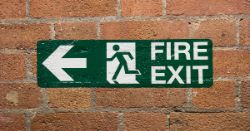A new standard to improve organizational fire safety risk management systems
Published date: |
|
Modified date: |
|
 Fire safety is an ongoing process, not a box to be ticked. Fire risk management (FRM) is not just about meeting minimum standards; it is about developing a strategic approach that integrates with other management systems and is suited to the size, structure and nature of the organization.
Fire safety is an ongoing process, not a box to be ticked. Fire risk management (FRM) is not just about meeting minimum standards; it is about developing a strategic approach that integrates with other management systems and is suited to the size, structure and nature of the organization.
A new standard, BS 9997:2019, Fire risk management systems – Requirements with guidance for use, sets out key principles and a methodology for fire safety risk management systems.
No room for complacency
As the Grenfell Tower Inquiry continues its investigations, public awareness of the importance of fire safety risk management is particularly keen.
The Grenfell fire in June 2017 killed 72 people when the blaze spread to the external cladding of the London tower block. It has been alleged that multiple parties, including the cladding manufacturers, building managers, building consultants and fire safety consultants, failed to give the safety of the tower cladding proper consideration.[1]
Shoddy construction endangers lives
A recent prosecution found that student accommodation in Trinity Halls, Woodhouse Street, Leeds fell far short of fire safety standards. The contractors that built, managed and let the facilities were found guilty of four breaches of law, including failing to make a suitable and sufficient fire assessment. They were fined a total of £670,000.
The property was found to have wholly inadequate fire safety (with some students more than twice the recommended distance from a fire exit), inadequate fire alarms and only one available fire escape for 27 students. The presiding judge said the building had 'potential for catastrophe'.[2]
Not just about personal safety
The risk to human life is, rightly, the paramount concern where fire safety is concerned. However, this is not the only reason why fire safety management matters. Business continuity, protection of assets such as premises, and environmental and social objectives are also important.
FRM systems encourage organizations to consider the full scope of risk to people, property and the environment.
Strengthening accountability
One of the key elements that emerged from the Grenfell Tower disaster is the lack of accountability in the construction and management of buildings. A 2017 review found that principal designers and contractors should have a critical role in embedding fire safety throughout the construction process.
BS 9997:2019 is designed to improve accountability and create a paper trail so that fire safety considerations can be tracked and monitored. The ideal is a clear, traceable pathway of information throughout the design and construction process.
Plan, do, check, act
The standard is intended to complement other BS 999X standards in using a 'plan, do, check, act' model for implementing, maintaining and improving an FRM system. The model is intended to assist with continuous improvement through establishing objectives, implementing processes, monitoring and measuring processes, and taking actions to improve FRM.
Who can use BS 9997:2019?
The standard is intended for use by organizations of various types, whether working across multiple sites, separate management divisions of an organization or a single organization working from individual premises.
It can be used by fire managers, risk managers, compliance managers, landlords and servicing companies, as well as fire and rescue services and fire risk assessors, and any other parties with an interest in organizational governance, risk and compliance.
A new standard to replace PAS 7:2013
The new standard takes the place of PAS 7:2013. With added detail, the British Standard also features an annex that cross maps its requirements with legal requirements in different parts of the UK. It also gives guidance on the use of the document.
The new standard is available from the BSI online shop.
Click here to provide feedback

